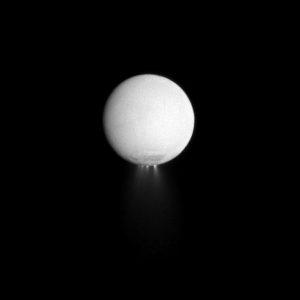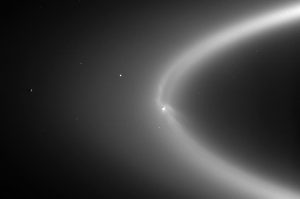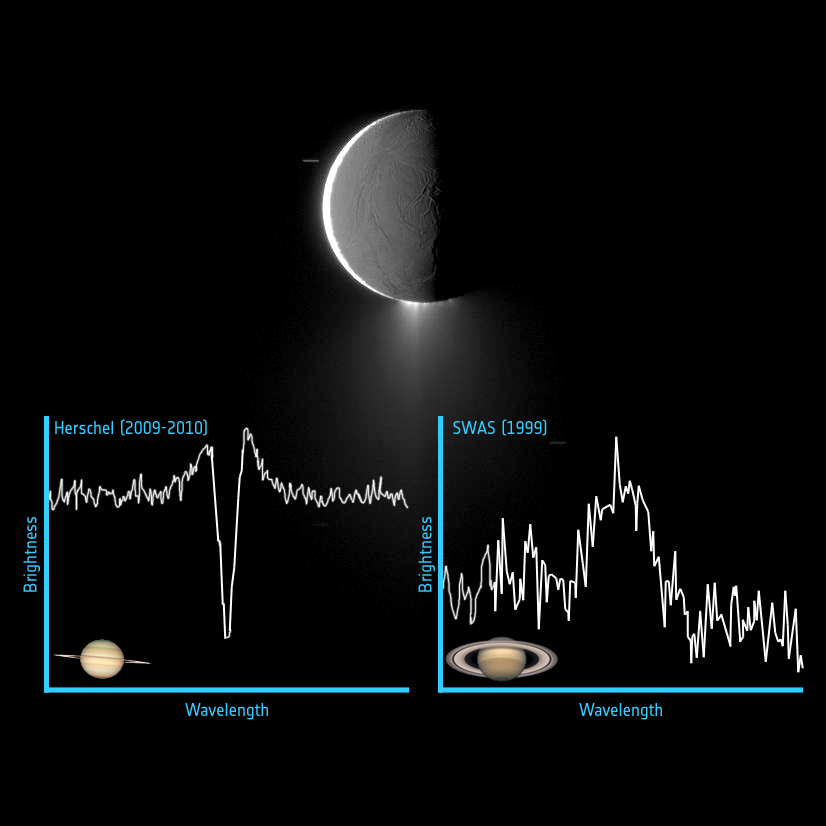| Basic Information | |
| What is this? | Enceladus, one of Saturn’s moons |
| Where is it in the sky? | Saturn orbits the Sun once every 30 years. |
| How big is it? | Enceladus is around 500 km in diameter |
| How far away is it? | Saturn orbits the Sun at a distance of 1.5 billion km, and Enceladus orbits Saturn at a distance of 240,000 km |
| What do the colours represent? | The background image is from the Cassini probe, in orbit around saturn. The spectra show the emission due to water seen by Herschel and the SWAS satellite |
Downloads
See this object in:

Herschel has shown that water expelled from Saturn’s moon Enceladus forms a giant ring around Saturn. It also explains the source of the water in Saturn’s upper atmosphere.
Enceladus, a small moon just 500 km in diameter, has fissures near its south pole, known as the Tiger Stripes, out of which it expels around 250kg of water ever second. The plume was discovered in 2004 by the Cassini probe, and is the origin of one of Saturn’s rings – the “E ring”. It also forms a very tenuous doughnut-shaped cloud, or torus, around Saturn, at a radius of around 10 times the radius of the planet.
The water in Saturn’s atmosphere was unexpectedly discovered in 1997 by the Infrared Space Observatory (ISO), and in 1999, the Submillimeter Astronomy Satellite (SWAS) showed that the water did not originate on Saturn. The atmospheres of the giant planets – Jupiter, Saturn, Uranus and Neptune – are not expected to contain water, and a popular theory was that the water was delivered by comets.
The new Herschel results show that almost all of it originated from tiny Enceladus. “This is the first time we see a moon directly acting on its host planet’s atmosphere and modifying its chemical composition,” commented Paul Hatoch from Max-Planck-Institut für Sonnensystemforschung in Katlenburg-Lindau, Germany, who led this study. “This unique situation has not previously been observed in the Solar System,” he added.
The water vapour is incredibly tenuous and transparent to visible light, though it is not transparent in the infrared. Both the Herschel and SWAS results are based on spectroscopy, spreading the light into a range of wavelength an identifying the emission from specific types of molecules. In 1999, SWAS only detected emission from water vapour in Saturn’s upper atmosphere, but 2009 and 2010 Herschel observed a dip in brightness due to some of the light being absorbed. The absorption must be due to water vapour in the foreground.

“The best explanation suggests that the water detected by Herschel is distributed in the Enceladus torus, a tenuous ring of material fed by this moon’s plumes and centred on its orbit,” explained co-author Emmanuel Lellouch from the Observatoire de Paris. The reason that SWAS did not detect this absorption is that in 1999 the Panet was tilted up by around 21 degrees, while when Herschel observed it in 2009-2010 the tilt was reduced to just 3 degrees – alomst completely edge-on. Saturn’s axis is tilted with respect to its orbit around the Sun, so our view from Earth changes over its 30 year orbit.
The Herschel data is used to predict the rate of water which enters Saturn’s atmosphere, and the result matches the measurements from the Cassini probe as it orbits the planet. Saturn’s largest moon, Titan, has a thick atmosphere containing water, but more than can be explained by the the emission from Enceladus.
“After Cassini’s detection of Enceladus’ plumes, Herschel has finally shown where the water emanating from this moon ends up – a nice piece of team work exploiting the complementarity of two very different missions in ESA’s Science programme,” comments Göran Pilbratt, ESA Herschel Project Scientist. “We now look forward to hopefully shedding new light on the origin of water in the atmosphere of Titan and the other giant planets as well,” he concludes.

